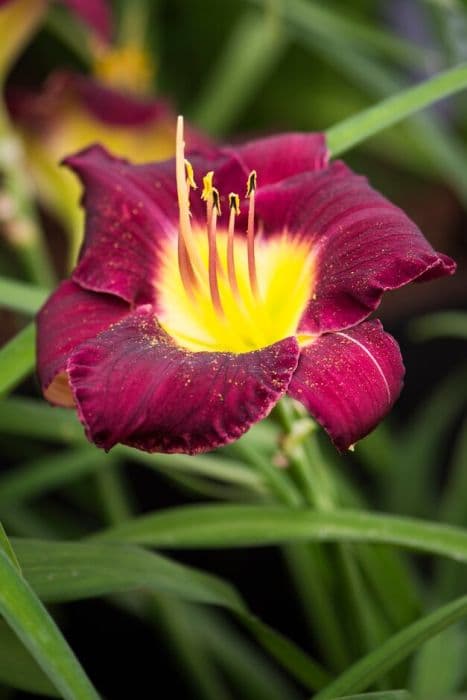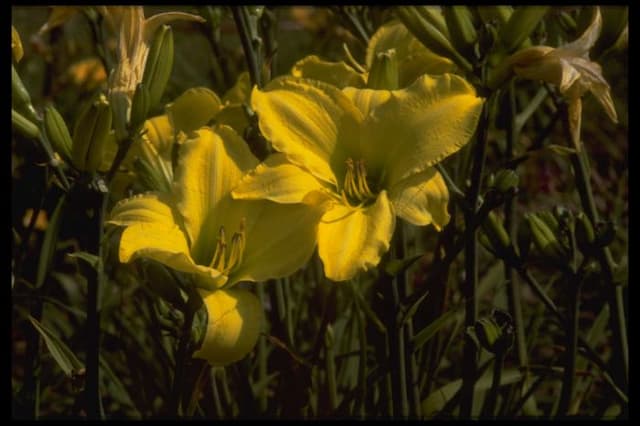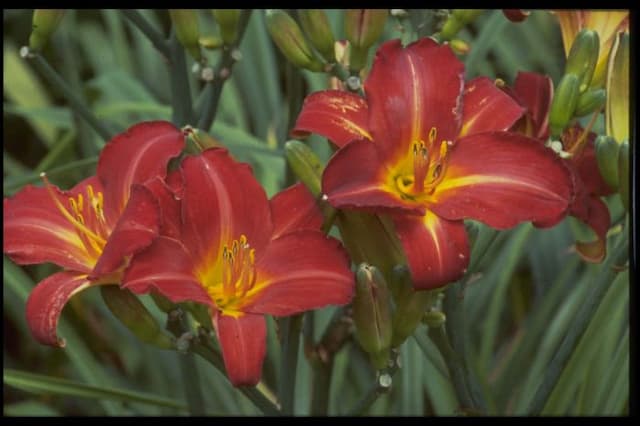Daylily Hemerocallis 'Doubloon' (d)

ABOUT
Hemerocallis 'Doubloon', commonly known as the daylily, is known for its striking blooms which are a feature of this perennial plant. The flowers of the 'Doubloon' variety are typically double, meaning they have more than one layer of petals, giving them a full and voluptuous appearance. The blooms exhibit a rich, golden-yellow hue that can brighten any garden space. Each individual flower has a symmetrical form, and the petals may display gentle ruffles along their edges, adding to the intricate beauty of the plant. These radiant flowers emerge from long, slender, green stalks that rise gracefully above a lush base of grass-like, green foliage. The leaves are long and blade-like, arching slightly and converging to create a dense clump which serves as an attractive backdrop for the dazzling flowers. The daylily 'Doubloon' blooms in the warmer months, typically offering its showy flowers that last for just one day, with multiple buds ensuring a prolonged display of color.
About this plant
 Names
NamesFamily
Hemerocallidaceae
Synonyms
Daylily, Doubloon Daylily
Common names
Hemerocallis 'Doubloon'
 Toxicity
ToxicityTo humans
Hemerocallis 'Doubloon' is a cultivar of the daylily, which is not typically considered toxic to humans. In fact, certain varieties of daylilies are edible and are sometimes used in culinary dishes, particularly in Asian cuisine. Daylily flowers are known to be edible when properly identified and prepared. However, it's always important to be certain of a plant's identification before any attempt at consumption, and individuals may have varying sensitivities or allergic reactions. Eating daylilies in large quantities could potentially cause gastrointestinal discomfort or other symptoms specific to personal sensitivities.
To pets
The daylily is known to be toxic to cats. Ingesting just a small amount of any part of the plant can cause kidney failure in felines. Symptoms of daylily poisoning in cats include vomiting, lethargy, inappetence, and general weakness. If a cat is suspected to have ingested daylily, immediate veterinary attention is crucial. The prognosis can be poor if treatment is delayed. There is less information regarding toxicity in dogs, but to be on the safe side, it is recommended to prevent dogs from ingesting daylilies as well.
 Characteristics
CharacteristicsLife cycle
Perennials
Foliage type
Deciduous
Color of leaves
Green
Flower color
Yellow
Height
2 feet [60 cm]
Spread
2 feet [60 cm]
Plant type
Herb
Hardiness zones
3-9
Native area
Asia
Benefits
 General Benefits
General Benefits- Easy to grow: Hemerocallis 'Doubloon' is hardy and adaptable, thriving in a wide range of soil conditions.
- Low maintenance: Daylilies require minimal care once established, with limited need for watering or fertilizing.
- Long blooming: They often bloom from early summer to fall, providing prolonged color in the garden.
- Variety of uses: Daylilies can be used in borders, as groundcover, or for erosion control on slopes.
- Drought tolerance: Once established, daylilies can withstand periods of drought, making them suitable for xeriscaping.
- Pest resistance: They are generally resistant to many pests and diseases, reducing the need for chemical treatments.
- Attracts pollinators: The flowers attract butterflies and bees, supporting local ecosystems.
- Edible parts: Certain parts of daylilies are edible, with buds and flowers used in culinary dishes.
- Landscaping versatility: With their arching leaves and colorful blooms, daylilies can complement many garden designs and styles.
- Propagation ease: Daylilies can be easily propagated by dividing the clumps, allowing gardeners to expand their displays or share with others.
 Medical Properties
Medical PropertiesThis plant is not used for medical purposes.
 Air-purifying Qualities
Air-purifying QualitiesThis plant is not specifically known for air purifying qualities.
 Other Uses
Other Uses- Daylily petals are edible and can be used in salads for a pop of color and a slightly sweet, vegetal flavor.
- The flowers can be used to make a naturally colored and flavored daylily wine with a unique taste.
- Dried daylily petals can be incorporated into potpourri mixes for their color and subtle fragrance.
- Fresh daylily blooms can be crystallized with egg whites and sugar to create an elegant and edible decoration for desserts.
- The robust root system of daylilies can help control erosion on slopes or areas where soil retention is needed.
- Daylily plants can be used in a dye garden; different parts of the plants produce different colors when used as a natural dye.
- The sturdy stems of daylilies can be used in floral arrangements to provide support to other, more delicate flowers.
- The fibrous material from daylily leaves can be used in paper-making for creating textured, artisanal paper.
- Daylily flower buds can be pickled in vinegar with spices to make a unique, savory condiment.
- When planted in a vegetable garden, daylilies can help attract pollinators like bees and butterflies, benefiting the entire garden ecosystem.
Interesting Facts
 Feng Shui
Feng ShuiThe Daylily is not used in Feng Shui practice.
 Zodiac Sign Compitability
Zodiac Sign CompitabilityThe Daylily is not used in astrology practice.
 Plant Symbolism
Plant Symbolism- Impermanence: The common name for Hemerocallis 'Doubloon' is Daylily, which refers to the fact that each flower typically lasts for only a day. This short lifespan symbolizes the fleeting nature of life and the importance of living in the moment.
- Renewal: Despite their individual flowers lasting only one day, Daylilies produce new flowers daily over the bloom period. This cycle of blooming represents renewal, rebirth, and the continuous thread of hope.
- Motherhood: In Chinese culture, Daylilies are associated with motherhood and motherly devotion due to their nurturing and daily renewal qualities.
- Forgetfulness: Daylilies can also symbolize forgetfulness or the loss of memory, as each bloom is quickly replaced by another, making it easy to "forget" the one that has passed.
- Resilience: Daylilies are known for their hardiness and ability to thrive in a variety of conditions, representing resilience and adaptability in the face of adversity.
 Water
WaterDaylilies require consistent moisture, especially during their peak blooming period in early to midsummer. Typically, watering about 1 inch of water per week, either through rainfall or manual watering, is sufficient. This amounts to roughly 0.6 gallons per square foot per week. In the absence of rain, provide supplemental water by soaking the soil around the plant, ensuring that it reaches the roots without wetting the foliage. During hot, dry periods, an additional watering may be necessary to keep the soil moist but not waterlogged. Overhead irrigation should be avoided to reduce the risk of disease.
 Light
LightDaylilies thrive in full sun, which means they need at least 6 to 8 hours of direct sunlight each day for the best growth and flowering. They can tolerate partial shade, particularly in hot climates where some afternoon shade can prevent scorching, but blooming may be reduced in less light. The ideal spot for a daylily is an area that receives morning sun and is protected from the intense late afternoon sun, especially in the hottest part of the summer.
 Temperature
TemperatureDaylilies are adaptable to a range of temperatures and can survive in USDA hardiness zones 3 to 9, withstanding minimum winter temperatures of -40 degrees Fahrenheit in zone 3. While they are cold-hardy, they flourish in an ideal temperature range of 60 to 75 degrees Fahrenheit during the growing season. They can tolerate summer heat well up to 90 degrees Fahrenheit but may require additional watering during these times to prevent stress.
 Pruning
PruningPruning daylilies involves removing spent flower stalks, also known as scapes, after blooming to encourage additional blooms and maintain a neat appearance. Deadheading, or removing old blooms daily, also promotes further flowering. Cutting back the foliage to the ground in late fall or early spring can help rejuvenate the plants and prevent disease. Pruning is typically done after the blooming cycle is complete, although some prefer to do it in spring before new growth begins.
 Cleaning
CleaningAs needed
 Soil
SoilDaylilies thrive in well-draining soil enriched with organic matter. A mix of loam, peat, and perlite or sand works well. Maintain a soil pH between 6.0 and 6.8 for optimal growth of 'Doubloon' daylilies.
 Repotting
RepottingDaylilies, including the 'Doubloon' variety, are not commonly grown in containers and thus do not require frequent repotting. They are typically planted directly in the ground and may be divided every few years to manage their growth.
 Humidity & Misting
Humidity & MistingDaylilies, including the 'Doubloon' variety, are tolerant of a wide range of humidity levels and do not require specific humidity conditions to thrive, making them versatile in various outdoor environments.
 Suitable locations
Suitable locationsIndoor
Ensure bright light and space for 'Doubloon' daylilies.
Outdoor
Plant in full sun, space well, fertile soil for 'Doubloon' daylilies.
Hardiness zone
3-9 USDA
 Life cycle
Life cycleThe Hemerocallis 'Doubloon', commonly known as the Daylily 'Doubloon', begins its life as a seed, which upon germination sprouts into a seedling. As it matures, it develops into a clump of grass-like foliage from which flower scapes emerge. The flowering stage occurs in early to mid-summer, showcasing large, double golden-yellow blooms that typically last for just one day, hence the name "daylily". After pollination, the flowers may produce seed pods if not deadheaded. The plant enters a period of dormancy during the colder months, with foliage dying back. In spring, the daylily resumes growth from its perennial rhizome, restarting the cycle.
 Propogation
PropogationPropogation time
Early Spring
Hemerocallis 'Doubloon', commonly known as the Daylily 'Doubloon', is best propagated by division. The ideal time to propagate by division is after the plant has finished flowering, typically in late summer to early fall. To propagate, carefully dig up the Daylily clump and gently separate the individual fans, which are groupings of leaves with their own roots. Each fan should have a healthy set of roots and a few leaves. Replant the divisions promptly, maintaining the same depth they were previously growing at, and water them thoroughly to help establish the new plants. This method allows the Daylily 'Doubloon' to continue thriving and producing its beautiful blooms in different locations within the garden or to be shared with other gardeners.









